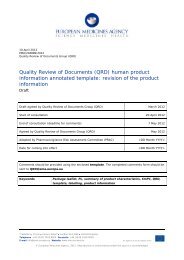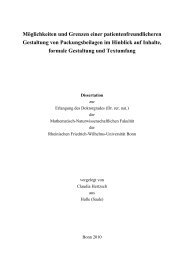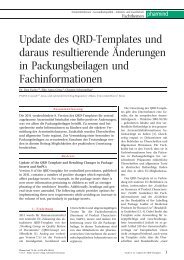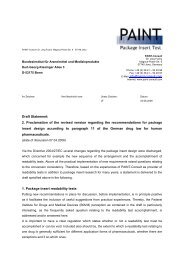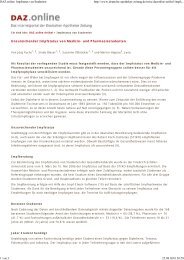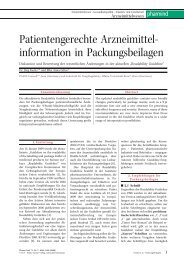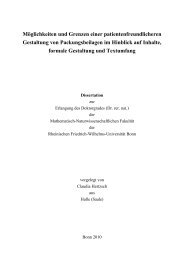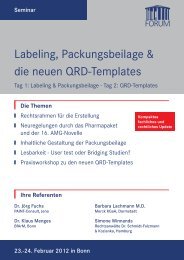New Font Size Requirements in Package Inserts of ... - PAINT-Consult
New Font Size Requirements in Package Inserts of ... - PAINT-Consult
New Font Size Requirements in Package Inserts of ... - PAINT-Consult
You also want an ePaper? Increase the reach of your titles
YUMPU automatically turns print PDFs into web optimized ePapers that Google loves.
Arzneimittelwesen · Gesundheitspolitik · Industrie und GesellschaftArzneimittelwesen pharm<strong>in</strong>d<strong>New</strong> <strong>Font</strong> <strong>Size</strong> <strong>Requirements</strong> <strong>in</strong><strong>Package</strong> <strong>Inserts</strong> <strong>of</strong> Medic<strong>in</strong>esAdvantages and disadvantagesDr. Joerg Fuchs 1,2 ,T<strong>in</strong>a Heyer 1,3 ,Diana Langenhan 1,3 und PD Dr. Marion Hippius 31 <strong>PAINT</strong>-<strong>Consult</strong> Ò ,Jena (Germany)2 Department <strong>of</strong> Drug Regulatory Aff airs at the Institute <strong>of</strong> Pharmacy, University <strong>of</strong> Bonn, Bonn (Germany)3 Department <strong>of</strong> Cl<strong>in</strong>ical Pharmacology, Friedrich Schiller University, Jena (Germany)IntroductionThe new “ Guidel<strong>in</strong>e on the readability<strong>of</strong> the labell<strong>in</strong>g and package leaflet<strong>of</strong> medic<strong>in</strong>al products for humanuse”, short “ readability guidel<strong>in</strong>e” ,was published by the European Commissionon12th <strong>of</strong> January 2009 [1]. Itis valid <strong>in</strong> each European UnionMember State and replaced the oldversion from September 1998, term<strong>in</strong>at<strong>in</strong>gthe extensive discussion surround<strong>in</strong>gthe draft readability guidel<strong>in</strong>epublished <strong>in</strong> September 2006 [2,AbstractThe readability guidel<strong>in</strong>e, updated <strong>in</strong> January 2009, conta<strong>in</strong>s variouschanges particular to package <strong>in</strong>serts, such as the use <strong>of</strong> am<strong>in</strong>imum9ptfont size. Readability test study results us<strong>in</strong>g two package <strong>in</strong>serts,pr<strong>in</strong>ted <strong>in</strong> diff erent font sizes between 7and 16 pt, clearlyillustrate that the new m<strong>in</strong>imum font size will improve readabilityand usability <strong>of</strong> this important patient <strong>in</strong>formation; particularly so,given that the newly recommended m<strong>in</strong>imum falls <strong>in</strong>to the optimalfont size range <strong>of</strong> between 9to11pt.ZusammenfassungNeue Bestimmungen zur Schriftgröße bei PackungsbeilagenDie im Januar 2009 aktualisierte Readability Guidel<strong>in</strong>e enthältverschiedene Änderungen, die besonders die Packungsbeilagenbetreff en, wie der Gebrauch der M<strong>in</strong>destschriftgröße von 9pt. E<strong>in</strong>eLesbarkeitsteststudie mit zwei Packungsbeilagen, gedruckt <strong>in</strong>Schriftgrößen von 7bis 16 pt, zeigte deutlich, dass die neue M<strong>in</strong>destschriftgrößedie Lesbarkeit und Benutzerfreundlichkeit dieserPatienten<strong>in</strong>formationen verbessern wird, da sie im Bereich des Optimumszwischen 9und 11 pt liegt.3]. The ma<strong>in</strong> aim <strong>of</strong> this guidel<strong>in</strong>e isto assist pharmaceutical companiesto better write and design package<strong>in</strong>serts and to improve labell<strong>in</strong>g andpackag<strong>in</strong>g <strong>of</strong> medic<strong>in</strong>es, so that theyare more easily comprehensible anduser friendly. However, the readabilityguidel<strong>in</strong>e is a recommendationaccord<strong>in</strong>g to the Community contract<strong>of</strong> the European Union, article249 [4], and therefore not b<strong>in</strong>d<strong>in</strong>g.One <strong>of</strong> themostimportantchangesconcerns the 9pt m<strong>in</strong>imum fontsize measured <strong>in</strong> Times <strong>New</strong>Roman.For market<strong>in</strong>g authorisation applicationsup until 1 st <strong>of</strong> February 2011, atransitional period shall apply dur<strong>in</strong>gwhich the old m<strong>in</strong>imum font size <strong>of</strong>8ptcont<strong>in</strong>ues to be acceptable [1,2]. With the newly-required 9ptm<strong>in</strong>imumfont size, the European Commissionputs <strong>PAINT</strong>-<strong>Consult</strong>’s recommendation,published <strong>in</strong> Pharm.Ind. <strong>of</strong> May 2008 [5], <strong>in</strong>to practisewhile distanc<strong>in</strong>g itself from its 2006draft guidel<strong>in</strong>e requir<strong>in</strong>g m<strong>in</strong>imumfont sizes <strong>in</strong> package <strong>in</strong>serts <strong>of</strong>between12 and 20 pt [3].<strong>PAINT</strong>-<strong>Consult</strong>’s 9pt m<strong>in</strong>imumfont size recommendation is basedon the company’s own font sizestudy [5]. Anadditional analysis <strong>of</strong>this study illustrates further advantagesand disadvantages <strong>of</strong> the newfont size demands.MethodThe font size study was performed <strong>in</strong>2007 at diff erentlocations <strong>in</strong> Thur<strong>in</strong>gia(Germany). Each participant evaluatedone <strong>of</strong> two telmisartan package<strong>in</strong>serts. The fi rst was available on theGerman medic<strong>in</strong>e market (the orig<strong>in</strong>alversion,n=1359 words). The secondwas a model version (n =579words), the orig<strong>in</strong>al package <strong>in</strong>sertoptimized us<strong>in</strong>g aset <strong>of</strong> 104 qualitycriteria. Both versions were pr<strong>in</strong>ted<strong>in</strong> every Arial font size from 7 to16 pt – except 15 pt – us<strong>in</strong>g as<strong>in</strong>glespac<strong>in</strong>g [5]. The layout, content,word<strong>in</strong>g, number and pr<strong>in</strong>t types perl<strong>in</strong>e were identical <strong>in</strong> each orig<strong>in</strong>al.l Zur Verwendung mit freundlicher Genehmigung des Verlages / For use with permission <strong>of</strong>the publisher lPharm. Ind. 72, Nr. 12, 2032 – 2036 (2010)©ECV · Editio Cantor Verlag, Aulendorf (Germany) Fuchs et al. · <strong>Font</strong> size <strong>in</strong>package <strong>in</strong>serts 1
pharm<strong>in</strong>dArzneimittelwesen · Gesundheitspolitik · Industrie und GesellschaftArzneimittelwesenl Zur Verwendung mit freundlicher Genehmigung des Verlages / For use with permission <strong>of</strong> the publisher lThe only diff erences were font size and formatsize. The same applied to the model package<strong>in</strong>sert.Am<strong>in</strong>imum <strong>of</strong> 5adolescents aged 13 to19 years and 5people aged 50 years plus wererecruited for each package <strong>in</strong>sert and fontsize, as accord<strong>in</strong>g to the <strong>PAINT</strong>1 survey, bothgroups have slightly more diffi culty locat<strong>in</strong>gand understand<strong>in</strong>g the <strong>in</strong>formation provided<strong>in</strong> package <strong>in</strong>serts [6]. Itisimportant to notethat visually impaired people were not excludedfrom this study.The written readability test method, as validated<strong>in</strong> the <strong>PAINT</strong>1 survey [6], was usedhere as it is an accepted test procedure acrossthe EuropeanUnion [1, 7] and avoids negative<strong>in</strong>fl uences on the results – such as due an <strong>in</strong>terviewer’sfacial expressions or gestures – <strong>in</strong>comparison to verbal <strong>in</strong>terview test methods.The questionnaire used requested demographicdata, followed by 15 questions relat<strong>in</strong>gto the package <strong>in</strong>sert’skey content and,afterwards, to 17 statements concern<strong>in</strong>g participants’personal op<strong>in</strong>ions about the package<strong>in</strong>sert. The follow<strong>in</strong>g three categorieswereused to evaluate the answers relat<strong>in</strong>g toall 15content questions:A) percentage <strong>of</strong> <strong>in</strong>formation not locatedB) percentage <strong>of</strong> <strong>in</strong>formation not comprehendedC) time needed to answer all 15 contentquestionsAfourth category concerns the section whichaddressed the participants’ op<strong>in</strong>ions aboutthe package <strong>in</strong>sert. Each participant used ascale with fi ve categories to assess diff erentaspects <strong>of</strong> the comprehensibility, legibility,complexity <strong>of</strong> <strong>in</strong>formation, clarity and structure,as well as their confi dence <strong>in</strong> the describedmedic<strong>in</strong>e. The answers were codedas follows: “ yes” =1 (best mark) up to“ no” =5 (worst mark). Medians were calculatedfor each <strong>of</strong> the 17statements, beforethe means per package <strong>in</strong>sert and font sizewere determ<strong>in</strong>ed.The fi nal step <strong>in</strong>volved apply<strong>in</strong>g ranges toeach <strong>of</strong> the four categories, for both the orig<strong>in</strong>alpackage <strong>in</strong>sert group and for the modelpackage <strong>in</strong>sert group. The font size <strong>of</strong> the orig<strong>in</strong>alpackage <strong>in</strong>sert with the lowest percentage<strong>of</strong> “ not found” <strong>in</strong>formation was ranked“ 1 ” ;asshown <strong>in</strong> Table 1; while the font sizeversion with the highest percentage wasawarded the worst rank mark <strong>of</strong> “ 9 ” .n Table 1Percentage <strong>of</strong> requested <strong>in</strong>formation which was not located (averages), the time needed to answer all 15content questions (calculated medians), percentage <strong>of</strong><strong>in</strong>formation not comprehended<strong>of</strong> the located contents (averages) and the participants’ personal op<strong>in</strong>ions (mean <strong>of</strong> the calculated medians from the 17statements), itemized for each orig<strong>in</strong>al and modelpackage <strong>in</strong>sert and respective font size [5].Number <strong>of</strong>participantsPersonal participants op<strong>in</strong>ionsconcern<strong>in</strong>g all 17 statements*Percentage <strong>of</strong> <strong>in</strong>formationnot comprehendedTime needed to answer all15 content questionsPercentage <strong>of</strong> <strong>in</strong>formationnot located<strong>Font</strong>size[pt]Orig<strong>in</strong>al Model Orig<strong>in</strong>al Model Orig<strong>in</strong>al Model Orig<strong>in</strong>al Model Orig<strong>in</strong>al Model[%] Rank [%] Rank [%] Rank [%] Rank [%] Rank [%] Rank [%] Rank [%] Rank7 9.8 5 5.7 7 14.5 6 12.0 7 19.0 3 10.8 4 2.26 6 1.92 9 13 148 8.5 2 6.7 9 15.0 7 11.0 6 27.2 9 9.8 2 2.12 3 1.69 5 11 129 12.1 7 3.4 4 13.6 4 10.0 1 27.0 8 10.4 3 2.02 1 1.61 4 11 1210 9.1 4 3.0 2 12.7 2 10.0 1 20.6 4 11.3 6 2.47 8 1.57 2 11 1111 12.2 8 2.8 1 13.9 5 10.6 4 15.0 1 11.6 7 2.10 2 1.59 3 11 1212 6.7 1 3.0 2 13.0 3 10.8 5 24.3 7 11.4 8 2.34 7 1.53 1 11 1113 10.9 6 4.4 5 15.0 7 12.7 8 18.5 2 9.2 1 2.22 5 1.70 6 11 1214 8.7 3 6.0 8 15.0 7 10.5 3 21.8 5 14.7 9 2.19 4 1.86 8 11 1016 16.0 9 4.8 6 11.8 1 13.7 9 22.9 6 10.9 5 2.54 9 1.85 7 10 11total 10.4 – 4.4 – 13.8 – 11.1 – 21.3 – 11.0 – 2.25 – 1.70 – 100 105*Ranges <strong>of</strong> assessment scales for participants’ personal op<strong>in</strong>ions <strong>of</strong> the package <strong>in</strong>serts: 1.00 to 1.50 = “ yes” (best mark), 1.51 to 2.50 = “ mostly yes” ,2.51 to 3.50 = “ other” ,3.51 to 4.50 = “ mostly no” ,4.51 to 5.00 = “ no” (worst mark).Pharm. Ind. 72, Nr. 12, 2032– 2036 (2010)2 Fuchs et al. · <strong>Font</strong> size <strong>in</strong>package <strong>in</strong>serts © ECV · Editio Cantor Verlag, Aulendorf (Germany)
ResultsIn total, 205 people participated <strong>in</strong>this study (age: 13 to 88 years;63.5 %female; 109 adolescents and96 adults aged 50 years plus).In all four categories, as well perfont size, the model package <strong>in</strong>sertgroup showed better results thanthe orig<strong>in</strong>al package <strong>in</strong>sert group(Table 1). Us<strong>in</strong>g the Mann-WhitneyU-test, the totalled results betweenthe orig<strong>in</strong>al and model package <strong>in</strong>sertswere always signi fi cant. Thiswas <strong>of</strong>ten additionally signifi cant <strong>in</strong>each font size <strong>in</strong>vestigated [5].In the category “ time needed toanswer all 15 content questions” advantageswere found <strong>in</strong> font sizes between9and 12 pt for both package<strong>in</strong>serts. This also applied to the modelpackage <strong>in</strong>sert <strong>in</strong> the categories“ percentage <strong>of</strong> <strong>in</strong>formation not located”and “ participants’ op<strong>in</strong>ions ”(Table 1). However, diff erences <strong>in</strong>the results between the n<strong>in</strong>e fontsizes <strong>in</strong>vestigated <strong>in</strong> each <strong>of</strong> the fourcategories, itemized per package <strong>in</strong>sert,were not signifi cant (H-testafter Kruskal-Wallis).The rank<strong>in</strong>gspresented<strong>in</strong>Table 1were added for each font size tested.The results clearly depict font sizesbetween 9and 11 pt pr<strong>in</strong>ted <strong>in</strong> Arialas the optimal range for package <strong>in</strong>serts(Fig. 1). The improvementcaused through use <strong>of</strong> these mediumfont sizes becomes more apparentthrough an overall view <strong>of</strong> the package<strong>in</strong>sert. Increas<strong>in</strong>g or decreas<strong>in</strong>gfont sizes outside the optimal 9to11 pt range serves only to reducethe usability <strong>of</strong>package <strong>in</strong>serts.Further to this, simply calculat<strong>in</strong>gthe rank sum once for the adolescentsand once for the adults aged50 years plus, illustrates that for bothparticipant groups these mediumfont sizes are the most appropriatefor use <strong>in</strong> package <strong>in</strong>serts. Aga<strong>in</strong>,use <strong>of</strong> smaller or larger font sizesonly led to adecrease <strong>in</strong> the package<strong>in</strong>serts ’ usability, regardless <strong>of</strong> theparticipant’sage group.n Figure 1Rank sum <strong>of</strong> the percentage <strong>of</strong><strong>in</strong>formation not located, the time needed to answerthe 15content questions, the percentage <strong>of</strong> <strong>in</strong>formation not comprehended and themean <strong>of</strong> the personal op<strong>in</strong>ions (Table 1)from the orig<strong>in</strong>al, aswell asthe modelpackage <strong>in</strong>sert, itemized for each Arial font size/x height.Arial font size [pt] Rank sum Arial font size [pt] Rank sum7 47 12 348 43 13 409 32 14 4710 29 16 5211 31DiscussionThe summarized results provided <strong>in</strong>Fig. 1clearly demonstrate that us<strong>in</strong>gm<strong>in</strong>imum 9ptfont size leads to animprovement <strong>of</strong> package <strong>in</strong>serts <strong>in</strong>comparison to the 8ptfont size <strong>of</strong>the old readability guidel<strong>in</strong>e. Us<strong>in</strong>gfont sizes <strong>of</strong> between 12and 20 pt,as stated <strong>in</strong>the readability guidel<strong>in</strong>edraft from December 2006 [3], wouldreduce the usability <strong>of</strong> package <strong>in</strong>sertsand, therefore, it is deemed agood decision to withdraw theselarge fonts.Additionally, the 9ptfont size canbe more readily <strong>in</strong>troduced, requir<strong>in</strong>gfewer adaptations to packag<strong>in</strong>gthan larger fonts. It must also benoted that us<strong>in</strong>gthe 9ptfont size allowsfor more words per l<strong>in</strong>e thanlarger fonts, thereby avoid<strong>in</strong>g hyphenation[5]. As well as this, the9ptfont size package <strong>in</strong>sert formatwill be more patient friendly thanwould be the case with the revokedreadability guidel<strong>in</strong>e draft font size.For example, theorig<strong>in</strong>al package <strong>in</strong>sertused for this study – which conta<strong>in</strong>ed1359 words – required apaperformat <strong>of</strong> around A4 pr<strong>in</strong>ted on bothsides,us<strong>in</strong>g the9pt font size.Increas<strong>in</strong>gthe font size to 12 pt led to amuchlarger and unga<strong>in</strong>ly A3 format [5].This is <strong>of</strong> particularimportance, asthe volume <strong>of</strong> texts used <strong>in</strong> package<strong>in</strong>serts <strong>in</strong>creases <strong>in</strong>exorably; <strong>in</strong> theyear 2000 German package <strong>in</strong>sertsconta<strong>in</strong>ed on average 1496 words[11], this had <strong>in</strong>creased to an average<strong>of</strong> 2005 words with<strong>in</strong> fi ve years – an<strong>in</strong>crease <strong>of</strong> 34 %[12]. The use <strong>of</strong> morecondensed word<strong>in</strong>g and greater optimisation<strong>of</strong> text volume dur<strong>in</strong>g readabilitytests will avoid format <strong>in</strong>creaseswhen the font size changesfrom 8to9pt [8]. However, it mustbe acknowledged, if us<strong>in</strong>g larger fontsizes, such as those <strong>of</strong> the readabilityguidel<strong>in</strong>e draft, number <strong>of</strong> wordsl Zur Verwendung mit freundlicher Genehmigung des Verlages / For use with permission <strong>of</strong>the publisher lPharm. Ind. 72, Nr. 12, 2032 – 2036 (2010)©ECV · Editio Cantor Verlag, Aulendorf (Germany) Fuchs et al. · <strong>Font</strong> size <strong>in</strong>package <strong>in</strong>serts 3
pharm<strong>in</strong>dArzneimittelwesen · Gesundheitspolitik · Industrie und GesellschaftArzneimittelwesenl Zur Verwendung mit freundlicher Genehmigung des Verlages / For use with permission <strong>of</strong> the publisher lcompressions cannot fully compensate.We must po<strong>in</strong>t out that Table 1o ff ers evidence <strong>of</strong> the existence <strong>of</strong>further important possibilities forimprov<strong>in</strong>g package <strong>in</strong>serts than arepossible through the use <strong>of</strong> largerfont sizes. For example, us<strong>in</strong>g theset <strong>of</strong> quality criteria which was appliedto the model package <strong>in</strong>sert,the total percentage <strong>of</strong> “ not located”<strong>in</strong>formation was reduced to 42.3 %and the percentage <strong>of</strong> “ not comprehended”contents to 51.6 %<strong>of</strong>the orig<strong>in</strong>alpackage <strong>in</strong>sert.Other available publications recommendthe use <strong>of</strong> larger font sizes,similar to the readability guidel<strong>in</strong>edraft [3]. However, these suggestionslargely <strong>in</strong>vestigate amaximum <strong>of</strong> twodiff erent font sizes between 12and18 pt [13, 14], or result from studieswhich have tested labels or texts withfewer than 500 words[15– 17]. Therefore,these fi nd<strong>in</strong>gs cannot fullyapplyto package <strong>in</strong>serts, which usuallyhave amuch larger volume <strong>of</strong> text.In contrast, studies <strong>in</strong> which awider range <strong>of</strong> font size was tested,us<strong>in</strong>g larger volumes <strong>of</strong> text, haveled to fi nd<strong>in</strong>gssimilar to those <strong>of</strong> thisstudy, because readers require fewereye fi xations with this font size.The new readability guidel<strong>in</strong>erecommendation: “ A type size <strong>of</strong>9po<strong>in</strong>ts, as measured <strong>in</strong> font ‘Times<strong>New</strong> Roman’...” also merits criticalanalysis, as9pt Times <strong>New</strong> Romanfont has an x-height <strong>of</strong> just 1.46 mmor acap height <strong>of</strong> 2.13 mm [1].This ismuch smaller than the x-height <strong>of</strong>9ptArial font (1.72 mm) or its capheight <strong>of</strong> 2.94 mm; and similar to8pt Arial font (x-height: 1.53 mm,cap height: 2.05 mm), therefore bothmay be used accord<strong>in</strong>g to the newreadability guidel<strong>in</strong>e.However, the fi gure clearly showsthat 8pt Arial font size is not <strong>in</strong>cluded<strong>in</strong> the range <strong>of</strong> optimal fontsizes. Indications exist to suggestthe readability <strong>of</strong> texts is more likelyto depend on aletter’sheight [22].Therefore, the fi nd<strong>in</strong>g that optimalfont sizes for package <strong>in</strong>serts <strong>of</strong> between9 to 11pt applies to Arialand may be transferred to similarlarge fonts, but not <strong>in</strong> generally toTimes <strong>New</strong> Roman.ConclusionUs<strong>in</strong>g am<strong>in</strong>imum 9ptfont size <strong>in</strong>package <strong>in</strong>serts will especially improvethe locatability <strong>of</strong> the medic<strong>in</strong>e<strong>in</strong>formation provided and can bemore readily put <strong>in</strong>to practise thanlarger font sizes. This will also exerta positive <strong>in</strong>fl uence on readability,thereby further<strong>in</strong>g the patient’smotivationto read package <strong>in</strong>serts and<strong>in</strong>crease the user’strust <strong>in</strong>the medic<strong>in</strong>e.Therefore, it becomes apparentthat, while not<strong>in</strong>g the existence <strong>of</strong>atransitional period until 1 st <strong>of</strong> February2011, pharmaceutical companiesshould implement this recommendationas soon aspossible.n REFERENCES[1] European Commission. Guidel<strong>in</strong>e on thereadability <strong>of</strong> the labell<strong>in</strong>g and packageleafl et <strong>of</strong> medic<strong>in</strong>al products for humanuse – Revision 1, 12. January 2009. http://ec.europa.eu/enterprise/pharmaceuticals/eudralex/vol-2/c/2009_01_12_readability_guidel<strong>in</strong>e_fi nal.pdf, accessed November 5,2009.[2] European Commission. Aguidel<strong>in</strong>e <strong>of</strong>the readability <strong>of</strong> the label and packageleafl et <strong>of</strong> medic<strong>in</strong>al products for humanuse. September 29, 1998. http://ec.europa.eu/enterprise/pharmaceuticals/eudralex/vol-2/c/gl981002.pdf, accessed November5, 2009.[3] European Commission. Guidel<strong>in</strong>e on thereadability <strong>of</strong> the label and package leaflet<strong>of</strong> medic<strong>in</strong>al products for human use.September, 2006. http://ec.europa.eu/enterprise/pharmaceuticals/pharmacos/docs/doc2006/09_2006/readability_consultation_2006_09_25.pdf, accessedNovember 5, 2009.[4] European Union. Consolidated versions<strong>of</strong> the treaty on European Union and <strong>of</strong>the treaty establish<strong>in</strong>g the Europeancommunity. OJ 2002;C325:1– 184.[5] Fuchs J, HeyerT,Langenhan D, Hippius M.The<strong>in</strong> fl uence fontsize has on the readabilityand comprehensibility <strong>of</strong> package<strong>in</strong>serts, PharmInd, 2008;70(5):584 – 592.[6] Fuchs J, Hippius M. Inappropriate dosage<strong>in</strong>structions <strong>in</strong> package <strong>in</strong>serts. PatEduc Couns. 2007;67:157–168.[7] The European Parliament and theCouncil <strong>of</strong> the European Union. Directive2004/27/EC <strong>of</strong> the European Parliamentand <strong>of</strong> the Council <strong>of</strong> 31 March2004 amend<strong>in</strong>g Directive 2001/83/EC onthe Community code relat<strong>in</strong>g to medic<strong>in</strong>alproducts for human use. OJ 2004;(L136):34–57.[8] Fuchs J. The way forward <strong>in</strong> package <strong>in</strong>sertsuser tests from aCRO’sperspective;Drug Information Journal. 2010;44(2):119 – 129.[9] Fritz Beske Institut für Gesundheits-System-Forschung.Alter und Gesellschaft –E<strong>in</strong>e Umfrage bei Mitgliedern der DAKzu Schwierigkeiten mit der Umwelt imAlltag. Kiel: Schmidt &Klaunig; 2009.[10] Twomey C. An analysis <strong>of</strong> patient <strong>in</strong>formationleafl ets supplied with medic<strong>in</strong>essold by pharmacists <strong>in</strong> the United K<strong>in</strong>gdom.Library and Information Research<strong>New</strong>s. 2001;25(80):3–12.[11] Fuchs J, Hippius M, Schaefer M. Analysis<strong>of</strong> German package <strong>in</strong>serts. Int JCl<strong>in</strong>Pharmacol Ther. 2006,44(1):8 – 13.[12] Fuchs J, Werner S, Schempfl ug C, Götze-Elstermenn K, Scheff el K, Domnowski A,Peter G, Hertzsch C, Hippuis M. Excessivemedical <strong>in</strong>formation <strong>in</strong>crease <strong>in</strong>package <strong>in</strong>serts. Int JCl<strong>in</strong> PharmacolTher. [<strong>in</strong> press].[13] Pr<strong>in</strong>ce J. Pr<strong>in</strong>t<strong>in</strong>g for the visually handicapped.Journal <strong>of</strong> Typographic Research.1967;1(1):31–47.[14] Eyles P, Skelly J, Schmuck ML. Evaluat<strong>in</strong>gpatient choice <strong>of</strong> typeface style andfont size for written health <strong>in</strong>formation<strong>in</strong> an outpatient sett<strong>in</strong>g. Cl<strong>in</strong>ical E ff ectiveness<strong>in</strong> Nurs<strong>in</strong>g. 2003;(7):94–98.[15] Drummond SR, Drummond RS, DuttonGN. Visual acuity and the ability <strong>of</strong> thevisually impaired to read medication <strong>in</strong>structions.Br JOphthalmol. 2004;(88):1541–1542.[16] Vanderplas JM, Vanderplas JH. Somefactors a ff ect<strong>in</strong>g legibility <strong>of</strong> pr<strong>in</strong>ted materialsfor older adults. Perceptual andMotor Skills. 1980;(50):923 – 932.[17] Smither JA, Braun CC. Readability <strong>of</strong>prescription drug labels by older andyounger adults. JCl<strong>in</strong> Psychol <strong>in</strong> MedSett<strong>in</strong>gs. 1994;1(2):149 – 159.[18] Bernard<strong>in</strong>i C, Ambrogi V, Fardella G,Perioli L, Grandol<strong>in</strong>i G. How to improvethe readability <strong>of</strong> the patient packageleafl et: asurvey on the use <strong>of</strong> colour,pr<strong>in</strong>t size and layout. PharmacologicalResearch. 2001;5:437–443.[19] Aberson DHA, Bouwhuis DG. Silentread<strong>in</strong>g as determ<strong>in</strong>ed by age and visualacuity. JRes Read<strong>in</strong>g. 1997;20(3):184– 204.[20] Paterson DG, T<strong>in</strong>ker MA. Infl uence <strong>of</strong>size <strong>of</strong> type on eye movements. JApplPsychol. 1942;(26):227– 30.[21] Paterson DG, T<strong>in</strong>ker MA. Studies <strong>of</strong> typographicalfactors <strong>in</strong>fl uenc<strong>in</strong>g speed <strong>of</strong>read<strong>in</strong>g: II size <strong>of</strong> type. JAppl Psychol.1929;13(2):120 – 30.[22] Roethle<strong>in</strong> BA. The relative legibility <strong>of</strong>diff erent faces <strong>of</strong> pr<strong>in</strong>t<strong>in</strong>g types. Amer JPsychol. 1912;23(1):1–36.Correspondence:Dr. Joerg Fuchs,<strong>PAINT</strong>-<strong>Consult</strong> Ò ,Friedrich-Engels Str. 19,07749 Jena (Germany),Fax: +49 36 41 54 93 97,e-mail: joerg.fuchs@pa<strong>in</strong>t-consult.comPharm. Ind. 72, Nr. 12, 2032– 2036 (2010)4 Fuchs et al. · <strong>Font</strong> size <strong>in</strong>package <strong>in</strong>serts © ECV · Editio Cantor Verlag, Aulendorf (Germany)
Chefredaktion: Claudius Arndt. Sekretariat: Gudrun Geppert. Verlag: ECV ·Editio Cantor Verlag für Mediz<strong>in</strong> und Naturwissenschaften GmbH, Baendelstockweg 20,88326 Aulendorf (Gemany). Tel.: +49 (0) 75 25 94 00, Fax: +49 (0) 75 25 94 01 80. e-mail: redaktion@ecv.de. http://www.ecv.de. Herstellung: stm media GmbH /druckhausköthen GmbH, 06366 Köthen (Germany). Alle Rechte vorbehalten.Bezugsbed<strong>in</strong>gungen: „ pharm<strong>in</strong>d“ ersche<strong>in</strong>t monatlich und kann vom Verlag oder durch e<strong>in</strong>e Buchhandlung bezogen werden. Preise für das Jahresabonnement alsPr<strong>in</strong>t-Ausgabe e<strong>in</strong>schließlich Onl<strong>in</strong>e-Zugang (<strong>in</strong>kl. MwSt., m<strong>in</strong>destens 12 Hefte): Inland: 248,00 € plus 29,00 € Versand. Ausland (Europa mit VAT ID Nr.): 222,43 € plus32,71 € Versand (Luftpost: 102,80 € ). Ausland (Europa ohne VAT ID Nr. undweiteres Ausland): 248,00 € plus 35,00 € Versand(Luftpost: 110,00 € ). Preis fürdas E<strong>in</strong>zelheft: je28,00 € plus Versand. Netzwerk-Erweiterungslizenzen auf Anfrage. Das Abonnement ist weiter rechtsverb<strong>in</strong>dlich, wenn es nicht m<strong>in</strong>destens 3Monate vor Ende desBerechnungszeitraums gekündigt wird. Kostenlose Probehefte liefert der Verlag auf Anforderung.Ó ECV ·Editio Cantor Verlag für Mediz<strong>in</strong> und Naturwissenschaften GmbH, Aulendorf (Germany).Pr<strong>in</strong>ted <strong>in</strong> Germany ·ISSN 0031-711 X




